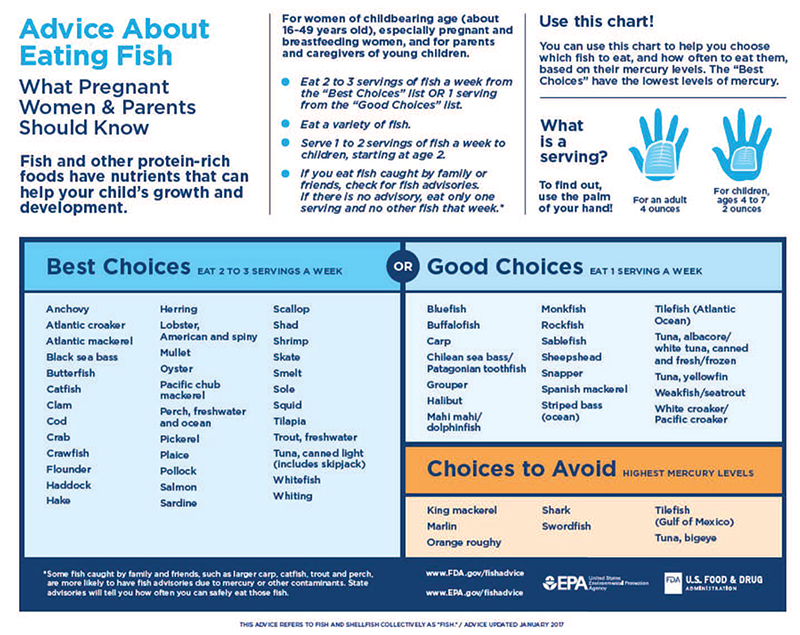Fish and shellfish are an important part of a healthy diet. Fish and shellfish contain high- quality protein and other essential nutrients, are low in saturated fat, and contain omega-3 fatty acids. A well-balanced diet that includes a variety of fish and shellfish can contribute to heart health and children’s proper growth and development. So, women and young children in particular should include fish or shellfish in their diets due to the many nutritional benefits.
However, nearly all fish and shellfish contain traces of mercury. For most people, the risk from mercury by eating fish and shellfish is not a health concern. Yet, some fish and shellfish contain higher levels of mercury that may harm an unborn baby or young child’s developing nervous system. The risks from mercury in fish and shellfish depend on the amount of fish and shellfish eaten and the levels of mercury in the fish and shellfish. Therefore, the Food and Drug Administration (FDA) and the Environmental Protection Agency (EPA) are advising women who may become pregnant, pregnant women, nursing mothers, and young children to avoid some types of fish and eat fish and shellfish that are lower in mercury.

By following these 3 recommendations for selecting and eating fish or shellfish, women and young children will receive the benefits of eating fish and shellfish and be confident that they have reduced their exposure to harmful effects of mercury.
1. These contain high levels of mercury, so do not eat them
2. Eat up to 12 ounces (two average meals) a week of a variety of fish and shellfish that are lower in mercury.
3. Check local advisories about the safety of fish caught by family and friends in your local lakes, rivers, and coastal areas.
If you regularly eat types of fish that are high in methylmercury, it can accumulate in your bloodstream over time. Methylmercury is removed from the body naturally, but it may take over a year for the levels to drop significantly. Thus, it may be present in a woman even before she becomes pregnant.
This is the reason why women who are trying to become pregnant should also avoid eating certain types of fish.
Before you go fishing, check your Fishing Regulations Booklet for information about recreationally caught fish. You can also contact your local health department for information about local advisories. You need to check local advisories because some kinds of fish and shellfish caught in your local waters may have higher or much lower than average levels of mercury. This depends on the levels of mercury in the water in which the fish are caught. Those fish with much lower levels may be eaten more frequently and in larger amounts.
For further information about the risks of mercury in fish and shellfish call the U.S. Food and Drug Administration’s food information line toll-free at 1-888-SAFEFOOD or visit the FDA’s Food Safety website. For further information about the safety of locally caught fish and shellfish, visit the Environmental Protection Agency’s Fish Advisory website or contact your State of Local Health Department. A list of state or local health department contacts is available. Click on Federal, State, and Tribal Contacts. For information on EPA’s actions to control mercury, visit EPA’s mercury website.
Page Last Updated: 06/24/2013
Accessibility Contact FDA Careers FDA Basics FOIA No Fear Act Site Map Transparency Website Policies
U.S. Food and Drug Administration
10903 New Hampshire Avenue
Silver Spring, MD
20993
Ph: 1-888-INFO-FDA (1-888-463-6332)
Phone: 262-544-4411
Fax: 262-650-3856
Monday-Thursday:
7:30 am – 6:00 pm
Friday:
7:30 am – 4:00 pm



